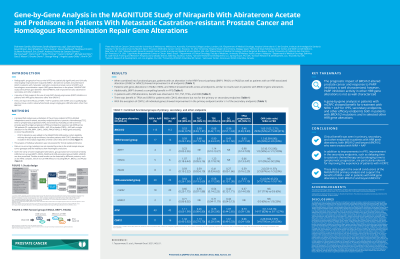Back

Industry Encore Posters
JL1015E: Gene by gene analysis in the MAGNITUDE study of niraparib (NIRA) with abiraterone acetate and prednisone (AAP) in patients (pts) with metastatic castration-resistant prostate cancer (mCRPC) and homologous recombination repair (HRR) gene alterations
Saturday, October 22, 2022
10:00 AM – 11:00 AM ET


Kristen Crowley, RN, MSN, APRN
Medical Science Liaison
Janssen Research & Development
Poster Presenter(s)
Background:
NIRA + AAP significantly improved outcomes in pts with mCRPC and HRR gene alterations in the Phase 3 MAGNITUDE study. There is a paucity of data supporting use of PARP inhibitors in pts with HRR gene alterations other than BRCA1/2. We report on the efficacy of NIRA + AAP in pts with mCRPC and a qualifying single gene HRR alteration other than BRCA1/2.
Methods:
A pre-specified analysis was undertaken of the primary endpoint (radiographic progression-free survival [rPFS] by BICR), secondary endpoints (time to cytotoxic chemotherapy [TCC], time to symptomatic progression [TSP], overall survival [OS]), as well as time to PSA progression (TPSA) and overall response rate (ORR) across 186 pts (91 randomized to NIRA + AAP, 95 to PBO + AAP) with an alteration in the ATM, BRIP1, CDK12, CHEK2, FANCA, HDAC2, or PALB2 gene (excluding cooccurring alterations). This analysis of individual alterations was not powered for formal statistical inference. Given the rarity of some alterations, groups based on functional similarity are also presented.
Results:
(Table). Pts with PALB2 or CHEK2 alterations had consistent improvement across all endpoints. In pts with ATM alterations benefit was observed in TCC, TSP, TPSA and ORR. There was benefit only in TPSA and ORR for pts with CDK12 alterations. When combined into functional groups, pts with an alteration in the HRR-Fanconi pathway (BRIP1, FANCA, and PALB2) as well as pts with a HRR associated alteration (CHEK2 or HDAC2) showed improvement in all endpoints.
Conclusions:
These data support the overall conclusions of the MAGNITUDE primary analysis and support benefit of NIRA + AAP in pts with HRR mutations beyond BRCA1/2.
Table
JL1015E Table
To view the table, please click on this link from the e-poster gallery on jadprolive.com
© 2022 American Society of Clinical Oncology, Inc. Reused with permission. This abstract was accepted and previously presented at the 2022 ASCO Annual Meeting. All rights reserved.
NIRA + AAP significantly improved outcomes in pts with mCRPC and HRR gene alterations in the Phase 3 MAGNITUDE study. There is a paucity of data supporting use of PARP inhibitors in pts with HRR gene alterations other than BRCA1/2. We report on the efficacy of NIRA + AAP in pts with mCRPC and a qualifying single gene HRR alteration other than BRCA1/2.
Methods:
A pre-specified analysis was undertaken of the primary endpoint (radiographic progression-free survival [rPFS] by BICR), secondary endpoints (time to cytotoxic chemotherapy [TCC], time to symptomatic progression [TSP], overall survival [OS]), as well as time to PSA progression (TPSA) and overall response rate (ORR) across 186 pts (91 randomized to NIRA + AAP, 95 to PBO + AAP) with an alteration in the ATM, BRIP1, CDK12, CHEK2, FANCA, HDAC2, or PALB2 gene (excluding cooccurring alterations). This analysis of individual alterations was not powered for formal statistical inference. Given the rarity of some alterations, groups based on functional similarity are also presented.
Results:
(Table). Pts with PALB2 or CHEK2 alterations had consistent improvement across all endpoints. In pts with ATM alterations benefit was observed in TCC, TSP, TPSA and ORR. There was benefit only in TPSA and ORR for pts with CDK12 alterations. When combined into functional groups, pts with an alteration in the HRR-Fanconi pathway (BRIP1, FANCA, and PALB2) as well as pts with a HRR associated alteration (CHEK2 or HDAC2) showed improvement in all endpoints.
Conclusions:
These data support the overall conclusions of the MAGNITUDE primary analysis and support benefit of NIRA + AAP in pts with HRR mutations beyond BRCA1/2.
Table
JL1015E Table
To view the table, please click on this link from the e-poster gallery on jadprolive.com
© 2022 American Society of Clinical Oncology, Inc. Reused with permission. This abstract was accepted and previously presented at the 2022 ASCO Annual Meeting. All rights reserved.

